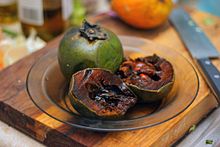 Black sapote Black sapote | |
| Type | Fruit |
|---|---|
| Region or state | Mexico, Central America and northern parts of South America |
Sapote (/səˈpoʊtiː, -eɪ, -ə/; from Nahuatl: tzapotl) is a term for a soft, edible fruit. The word is incorporated into the common names of several unrelated fruit-bearing plants native to Mexico, Central America and northern parts of South America. It is also known in Caribbean English as soapapple.
Species
From Sapotaceae
Some, but not all sapotes, come from the family Sapotaceae:
- Sapodilla, also called naseberry (Manilkara zapota) is native to Mexico, Guatemala, Nicaragua, Belize, and possibly El Salvador. The Sapotaceae were named after a synonym of this species.
- Yellow sapote (Pouteria campechiana) is native to Mexico and Central America.
- Mamey sapote (Pouteria sapota) is from southern Mexico to northern South America.
- Green sapote (Pouteria viridis) is native to lowland southern Mexico.
-
Manilkara zapota, Hồng xiêm, a kind of Vietnamese sapote
-
 Pouteria sapota, mamey sapote
Pouteria sapota, mamey sapote
-
 Manilkara zapota, sapodilla
Manilkara zapota, sapodilla
-
 Pouteria campechiana, yellow sapote
Pouteria campechiana, yellow sapote
From other families
- Black sapote (Diospyros nigra: Ebenaceae), from eastern Mexico south to Colombia, is probably the original Aztec tzapotl.
- White sapote (Casimiroa edulis: Rutaceae) is native to northern and central Mexico, Costa Rica, El Salvador and Guatemala.
- South American sapote (Quararibea cordata: Malvaceae) is native to the Amazon rainforests of Brazil, Venezuela, Colombia, Ecuador, and Peru.
- Sun sapote (Licania platypus: Chrysobalanaceae) is native to southern Mexico south to Colombia.
-
 Casimiroa edulis, white sapote
Casimiroa edulis, white sapote
-
 Quararibea cordata, South American sapote
Quararibea cordata, South American sapote
See also
- Chapote (Diospyros texana: Ebenaceae) is native to the lower Rio Grande valley region in Texas and Mexico
References
- ^ "sapote". Merriam-Webster.com Dictionary. Merriam-Webster.
- ^ "sapote". WordReference.com Dictionary of English. Retrieved 26 March 2024.
- ^ "sapote". Oxford English Dictionary (Online ed.). Oxford University Press. doi:10.1093/OED/3396265629. Retrieved 2024-03-26. (Subscription or participating institution membership required.)
- ^ Watson, George (April 1938). "Nahuatl Words in American English". American Speech. 13 (2): 113–114. doi:10.2307/451954. JSTOR 451954.
tropical evergreen tree Achras sapota sapote derivative from Nahuatl tzapotl. The Spanish diminutive form gave English sapodilla in the same sense
- ^ Morton, Julia F. (1987). Chupa-Chupa. Miami, FL. pp. 291–292. ISBN 978-1626549722. Retrieved 26 March 2024 – via Purdue University Horticulture & Landscape Architecture.
{{cite book}}: CS1 maint: location missing publisher (link) - Small, Ernest (2011). Top 100 Exotic Food Plants. Boca Raton, Louisiana, USA: CRC Press. ISBN 9781439856888.
- "Casimiroa edulis". Germplasm Resources Information Network. Agricultural Research Service, United States Department of Agriculture. Retrieved 2009-03-26.
If an internal link led you here, you may wish to edit the linking article so that it links directly to the intended article. Categories: